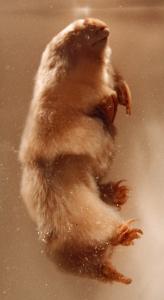
MARSUPIAL MOLES
SUPER COHORT MARSUPIALIA
COHORT AUSTRALIDELPHIA
ORDER NOTORYCTEMORPHIA
FAMILY NOTORYCTIDAE
| The two living species of marsupial moles
(Notoryctes typhlops and N. caurinus) are the only
marsupials with a fossorial (burrowing),
subterrranean, life style. They live in sandy soils in the deserts
of Central Australia. Feeding on arthropods, especially the larvae
of scarab beetles, and small lizards, they obtain water from their
food and conserve it by being active at night. Their dental formula is I4/3; CI/I; P2/3; M4/4.
Marsupial moles have specialized features that enable them to burrow with ease:
Marsupials moles greatly resemble the true moles (family Talpidae) and the Golden mole (family Chrisochloridae) in appearance. Strangely marsupial moles, unlike other fossorial mammals, dig burrows which collapse behind them as the moles move along through the soil! |
 Notoryctes typhlops |
| Bandicoots | Dasyurids | |
| Thylacine | Koala | Wombats |
| Kangaroos | Possums | Feathertail or pygmy glider |






